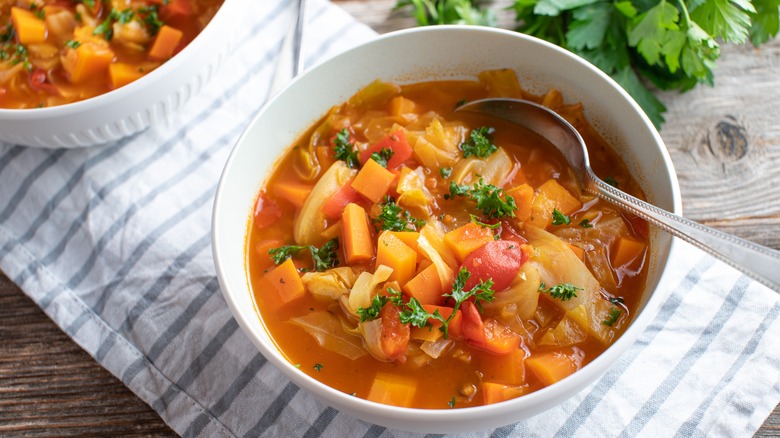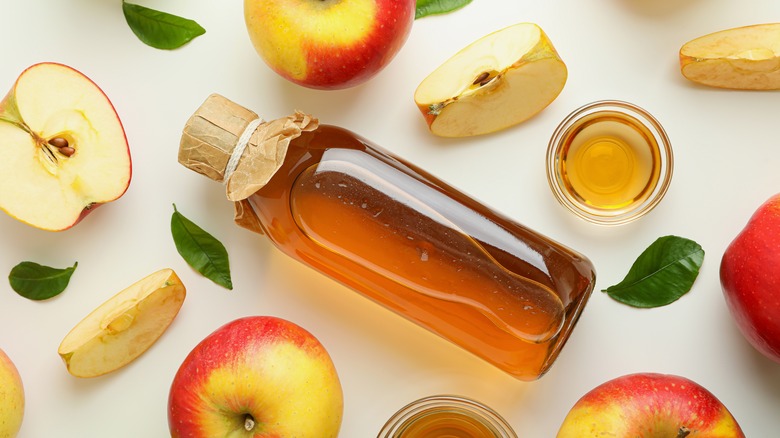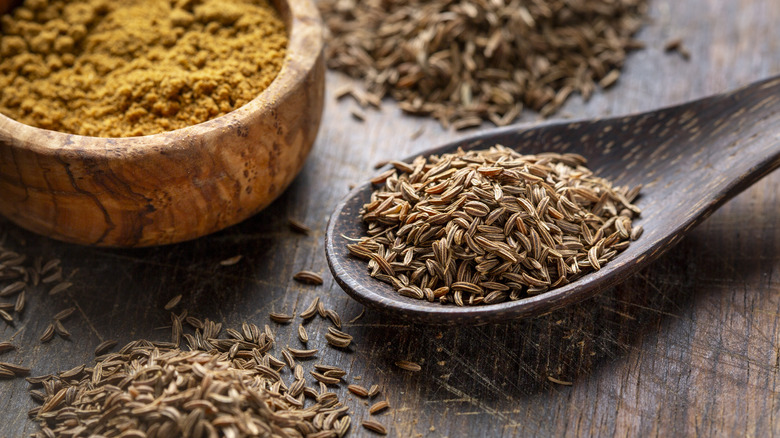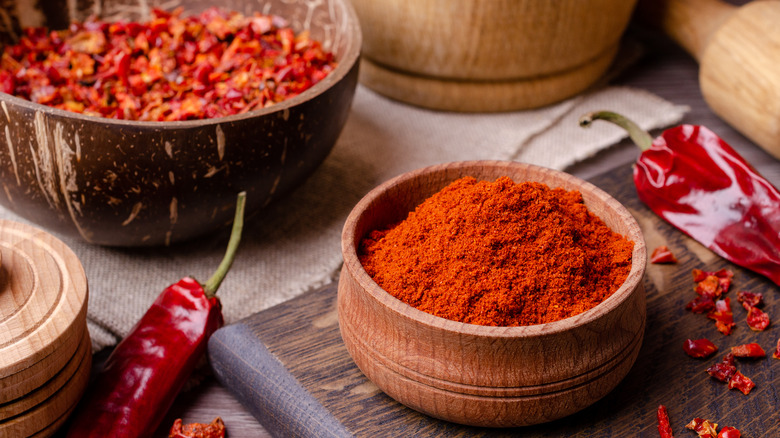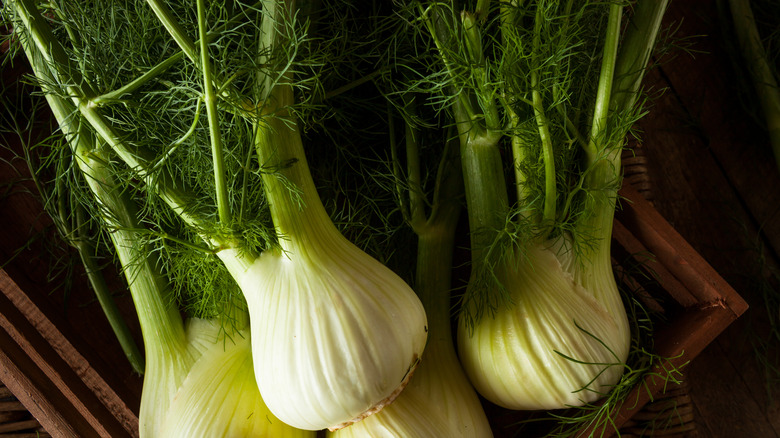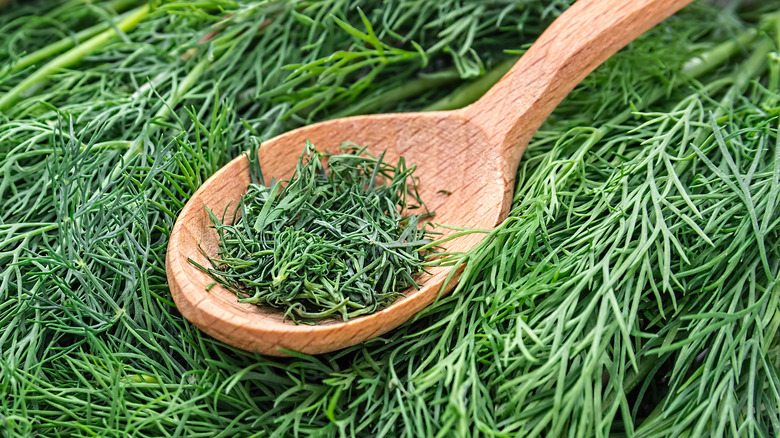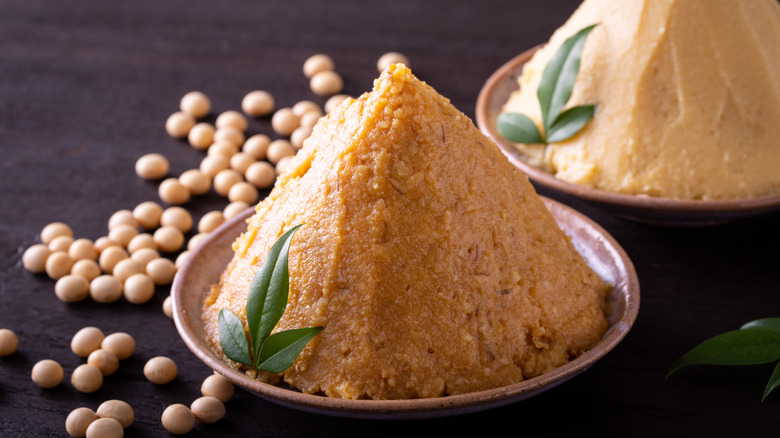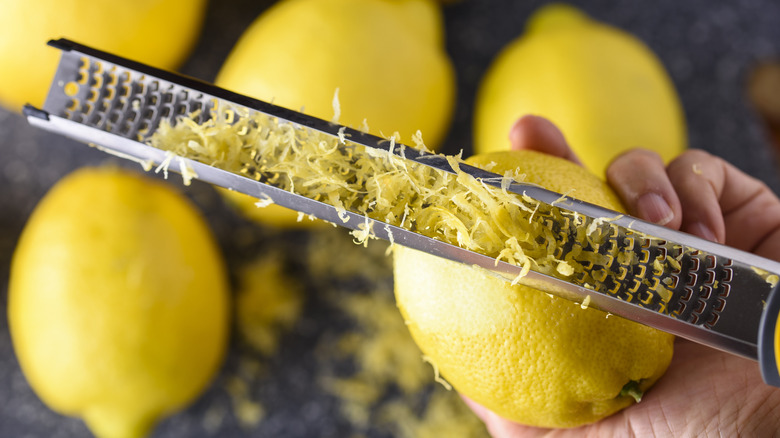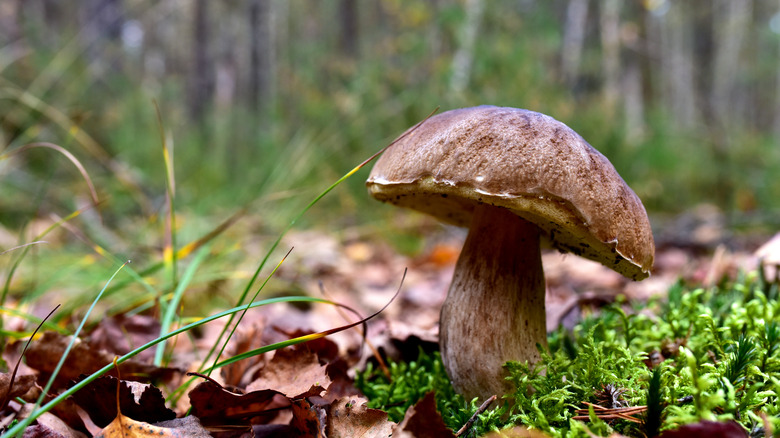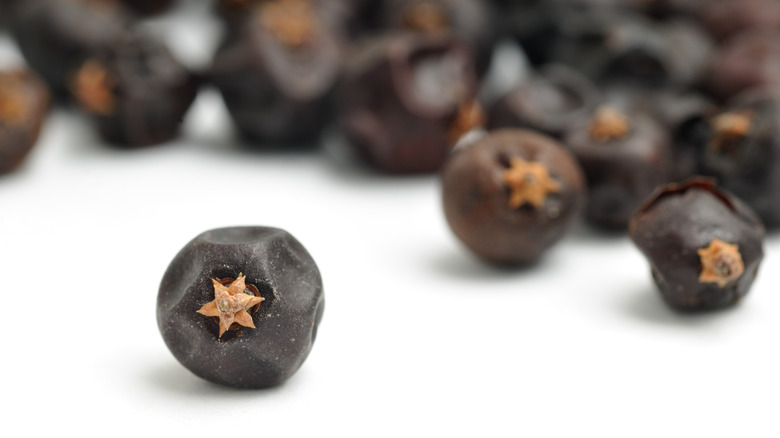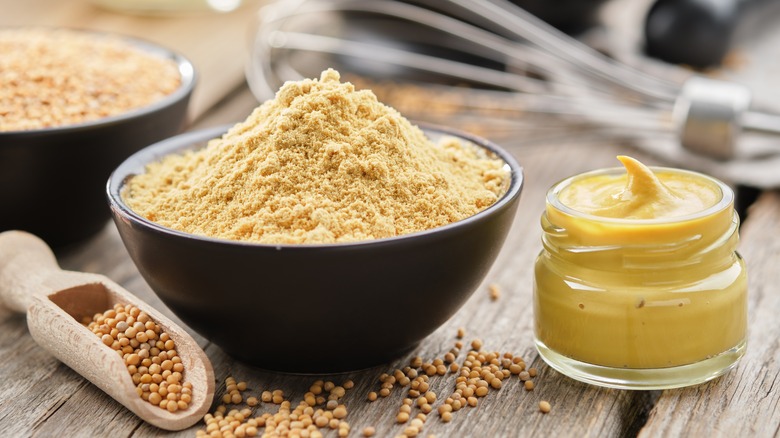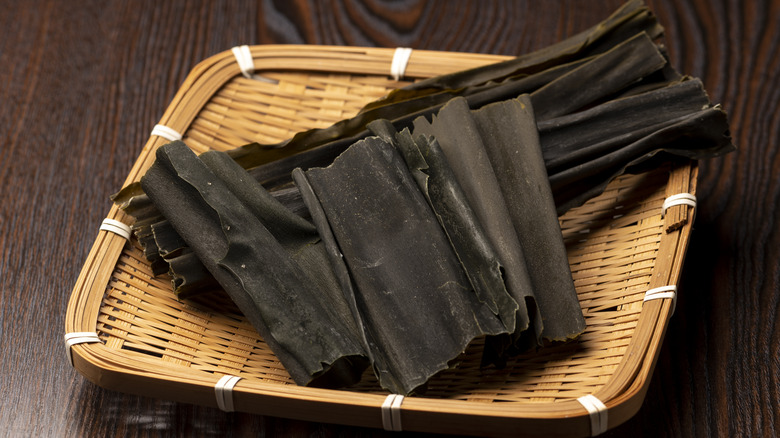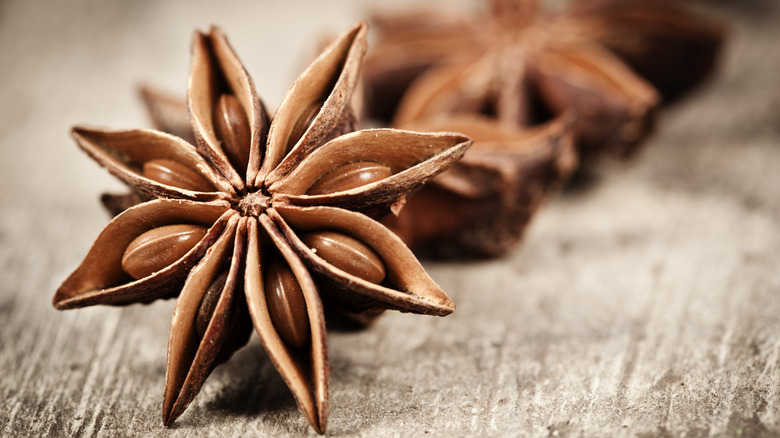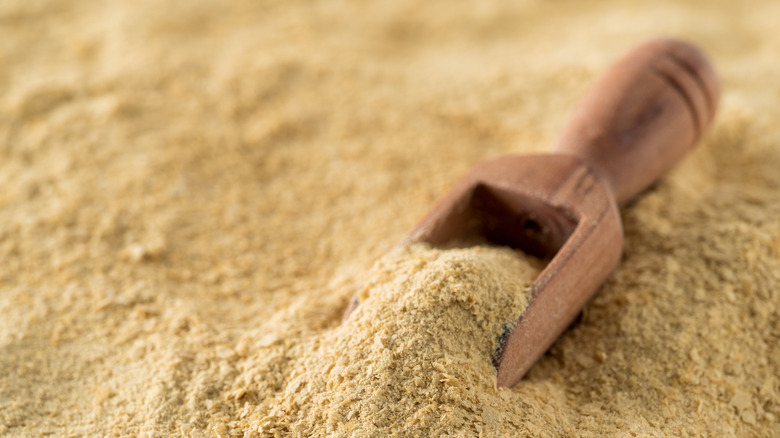13 Secret Ingredients You Should Be Using In Your Cabbage Soup
The culinary world is blessed with over 400 types of cabbage, but not everyone sees it that way. This sturdy vegetable appears both in spring when we're ready for fresh, sweet, and bitter vegetables and by the end of fall when it's time to fill the root cellar for the winter. Cabbage is mostly relegated between raw summer coleslaw and stuffed and baked in the winter. Adventurous home cooks might experiment with fermenting kimchi or sauerkraut, and some families celebrate the New Year with cabbage. Still, many people walk right on by this affordable, tasty, nutritious vegetable.
Enter cabbage soup. Not only is it a great way to make a hearty meal for a tiny price, but it's also delicious, filling, and ridiculously easy to make. You can customize your soup as your palate sees fit, tossing in any leftover proteins (or beans to keep it vegan or vegetarian).
Are you cabbage-curious and ready to explore the possibilities posed by this unsung hero of the produce section? Creating a standout cabbage soup comes down to adding unexpected ingredients that elevate the dish from simple to memorable. Here are 13 secret ingredients that can add depth, complexity, and a touch of surprise to your cabbage soup.
Apple cider vinegar
Apple cider vinegar is a pantry staple that can really bring a soup together. The most balanced soups consider the five tastes: sweet, salty, bitter, sour, and umami. When cooked, cabbage has a natural sweetness that can be one-note without the contrasting tang of an acid, and apple cider vinegar is perfect. Not only does it mediate any accidental oversalting that occurs, but it also brightens and lifts the entire soup.
Choose the correct vinegar for the best taste and nutrition. Those glowing golden bottles of purified vinegar look pretty but don't do much for your health or the soup's taste. Look for organic varieties that are cloudy or have debris at the bottom of the bottle. That debris is the mother, the fermenting lifeblood of the vinegar, and it's packed with nutrients. Glass bottles are better than plastic, and raw or unpasteurized vinegar has more living nutrients than pasteurized.
Add vinegar to the braising liquid if you are cooking cabbage down slightly before adding it to the soup. If you're going the one-pot route and cooking cabbage down with the other ingredients, bring your ACV to the table and let people add a splash before digging in.
Caraway seeds
Caraway seeds come from plants in the parsley family. They are native to Europe, Africa, and Asia and have been used as both a culinary herb and a stomach-settling medicinal treatment. Their unique taste is what gives rye bread its signature flavor. Underlying notes of anise and a bittersweet flavor profile pair well with cabbage. Caraway seeds are often added to slaw, which is just chopped fresh cabbage, so it makes sense that their addition would elevate a humble cabbage soup.
Add the seeds to your aromatics, toasting them briefly to open up the spice's flavor. Cumin, fennel, dill, and black pepper are all complementary seasonings, so don't be afraid to mix and match to taste. If using ground caraway, add to your aromatics and stir briefly before adding the liquid. Be mindful that powdered spices are always more intense than their whole-seed counterparts, and adjust accordingly. You can also toast your own whole caraway seeds and grind them with a mortar and pestle. This gives you the best of both worlds: the freshness of the whole seed and the intensity of the powder.
Smoked paprika
Paprika is made by drying sweet red peppers and grinding them to a powder. The dried peppers are smoked over fire before being ground for a rich, deep, smoky flavor. The difference that this simple step can make in your soup is somewhat shocking. Paprika, in general, adds color and slight sweetness to the final soup, but smoking it changes the flavor profile altogether. The spice becomes richer and more rounded, with a depth plain paprika doesn't have (except in large amounts unsuitable for cabbage soup). The flavor is earthy and vegetal, an excellent pairing with sweet cabbage.
Look for dusty red spice, bright with the original red pepper but musky with smoke. Plain paprika's flavor is delicate, which means it can be used in large amounts without being overwhelming, but smoked paprika has a more robust flavor. Regardless of the type you select, add it near the end of cooking so the heat does not destroy its flavor.
Fennel bulb
Fennel is related to cabbage not botanically but in how it is viewed. Regular supermarket denizens walk by this member of the carrot family, with its large, strangely shaped bulb and elegant, wispy fronds. As with cabbage, questions about fennel's appearance and its preparation abound: Is the stalk celery? Are the fronds edible? How do you use fennel? No, and yes, and we're just scratching the surface. Raw fennel is crunchy and tastes strongly of licorice; it can be eaten raw, chopped into salads, or roasted and added to sandwiches. In cabbage soup, fennel provides a complex, sweet flavor with a hint of licorice's bitterness — a perfect foil.
Chopped fennel can be added with the aromatics or with the cabbage itself. Roasting it before it adding caramelizes some of the natural sugars and adds depth, but this step is unnecessary. The stalks and the bulb can be added during cooking, but don't toss the fronds. Chop these roughly and float them on top of the soup when serving for an interesting, herbaceous kick.
Dill weed
Dill is an herb in the same family as celery; as such, it falls into the category of aromatics, those soup starters that lay down the bass note of a soup's complex symphony of flavors. Dill is used either as the weed (the delicate greenery that crowns the plant) or as a seed that resembles caraway seeds. This herb spreads easily throughout the garden and can even be found growing wild. The flavor of the weed is much stronger than the seed's, but both can be used in everything from pickles (arguably dill's best-known use) to sweet and sour cabbage soup.
Dill's grassy flavor smacks of anise or even lightly of caraway, both of which are suitable substitutions in any recipe that calls for dill. You can use the whole seed in cabbage soup or add roughly chopped dill weed as a garnish when serving. If using dill fresh from your garden, watch out for bolting. Hot weather changes the leaves' flavor, making them more bitter. They can still be used but will taste different.
White miso paste
White miso paste has a strong umami flavor that brings a beautiful richness and body to a lighter cabbage soup. It's made by fermenting soybeans with salt and koji (a specific type of mold). Other ingredients like barley and rice may be added for a different flavor. When the fermenting process has finished, the resulting paste is salty, a bit sour, and packed with flavor.
White miso works well in cabbage soup because of the addition of rice during fermenting. Unlike red miso, with its intense flavor and dark color, white miso is more delicate and is less pushy on the palate. Whereas red miso would charge ahead, punching the cabbage and other spices out of the way, white miso wraps its lovely tendrils around the ingredients, inviting them to dance and leading the way. Buying the best quality white miso is the move here — more expensive varieties have higher levels of beneficial bacteria, making your soup good and good for you. You don't need much to bump up the flavor; just a tablespoon or two swirled into your batch of soup will do the trick.
Lemon zest
Just as apple cider vinegar brings a punchy bright hit of acid to the dinner table, so, too, does lemon zest pump up the volume on flavor. Citrus, in general, is a brightener of food, as its sunny shape and color suggest. But there's one real bonus to adding the zest and skipping the juice: The zest elevates the soup's flavor without adding additional acid. Zest is the way to go if you've already used apple cider vinegar in cooking and want another layer of freshness without adding more liquid or acid. Zesting a lemon also releases all its fragrant oils, bringing another dimension to your dining experience.
Zest carefully immediately before serving. Use a lemon zester to remove only the yellow part of the lemon and none of the bitter pith between the peel and the fruit's flesh. Use only organic lemons, and scrub the fruit carefully before zesting to remove any stubborn dirt or wax.
Porcini mushrooms
Porcini mushrooms — also referred to as ceps, Penny Bun, and King Bolete — are fat and meaty, the perfect earthy addition to your cabbage soup. Their stalks are white and chunky and support a wide brown cap (up to a foot in diameter, but that's exceptional). The season for porcini is short, which makes them pricey. They taste of the ground in which they are grown and can be consumed either fresh or dried and then rehydrated. Dried tastes just as delicious as fresh and is a more affordable option.
Clean your fresh porcini mushrooms with a paper towel, removing visible dirt but not rinsing in water. All mushrooms are highly absorbent, and the addition of water can compromise their structure. Ironically, dried porcini need to be rehydrated. If using dried porcini, soak them briefly in warm water until they regain their shape and volume. They can be chopped finely and added after the aromatics are ready but before adding the liquid. Alternately, they can be roasted separately until brown and then added to the soup as a garnish for serving.
Juniper berries
Juniper berries, the main ingredient in gin, give it a floral bouquet and flavor, and they can perform similar magic in your cabbage soup. German cuisine uses juniper in everything from game meats to sauerkraut (fermented cabbage); it imparts a citrusy flavor with piney overtones, similar to rosemary but with more floral notes. These small, pungent berries (actually tiny cones on a juniper bush) hold their own in heavy stews and meaty dishes, but they are just as comfortable in a lighter soup.
Berries can be toasted lightly to bring out even more of their tasting notes, but be careful not to burn them as they will become bitter. You can also skip that step and simply crush them lightly. Use a mortar and pestle, or place a tablespoon of berries in a zip-top plastic bag and bash them gently with a rolling pin — some advocate using the berries in a mesh bag so they can be removed from the soup before serving. If you don't mind a burst of pine flavor when you chew on one, just add them to the soup. Otherwise, place them in a small muslin bag and remove them when the soup's done.
Mustard
If you have ever slathered it on a kraut-covered hotdog, chances are good you already understand the magic that mustard works on cabbage. Mustard adds a spicy zip that cuts through fat and heavy meats like a hot knife through butter, but it's also a flavor enhancer that lifts and elevates while simultaneously grounding the dish. Yes, it's an ethereal combination, and it works brilliantly in cabbage soup.
Better still, mustard can be used for soup in any of its forms, from whole mustard seeds toasted with the aromatics to powder added mid-way through cooking and a squeeze of yellow or dollop of Dijon served tableside. Each form brings a different quality to your soup. Prepared mustard has the added bonus of vinegar and other seasonings. The vinegar is mild but does elevate the other flavors with a jolt of acid, just like that yellow mustard makes that sloppy hotdog taste even better. If you choose to add different forms of mustard, taste as you go to maintain the proper balance and not overwhelm the sweetness of cabbage in the final soup.
Kombu (dried seaweed)
Seaweed is just floating algae that has worked its way to the top of the superfoods list. It's common in Japanese cuisine but has spread to other culinary traditions due to its mineral-rich umami flavor. Kombu, a specific form of seaweed, is an excellent addition to cabbage soup. Unlike nori, a crispy seaweed eaten as a snack, kombu is used to flavor broths and soups and then discarded; its rubbery texture is unpleasant and difficult to eat.
Kombu is filled with naturally occurring monosodium glutamate (MSG), a compound that enhances flavor. Not sure where to find kombu? You don't have to forage your seaweed like Martha Stewart does. It's available in the international aisle of most grocery stores. Some packaged kombu is covered with a white film. This is dried salt that can be removed with a damp paper towel. Wipe the kombu clean, add a 4-inch piece to your soup as it cooks, then remove it before serving.
Star anise
There's a trend here: Cabbage loves any kind of herb or spice with a licorice undertone, and star anise is the last ingredient on the list that brings this flavor to the table. With its distinctive shape and beautiful taste, star anise is a fine addition to any cabbage dish but shines in soup. Whole pods can be simmered in the soup, but this spice can also be ground and added later on in cooking. Remember that ground powder is intensely flavored — a little goes a very long way, so use a cautious and light hand, especially when cooking for people who aren't sold on the idea of licorice in soup.
Even when using the whole star, just one or two will do the trick. If you are grinding star anise to use in powdered form, only grind as much as you'll use immediately, as this spice starts to lose its flavor immediately after grinding.
Nutritional yeast
What is nutritional yeast? Some consider it the poster child for vegan cuisine. It's the secret ingredient in vegan cheese, lending a trademark nuttiness to the other ingredients that make up the body of this popular substitute for dairy cheese. Nutritional yeast, not to be confused with the yeast used in baking, goes by the nickname nooch and is sold in both flakes and powder, either of which are appropriate additions to cabbage soup. It starts with regular yeast that is fed a high-glucose carbohydrate. This yeast ferments and grows big and strong, at which time the yeast is pasteurized, sometimes fortified, then dried and ground into flakes or powder.
Nooch is not meant to be heated, so the best way to get this hit of flavor (and vitamin B12) is to sprinkle it on at the end. Some vegans swear it tastes like cheese, but you'll have to try it and judge that for yourself. If you can't get enough cabbage, even after trying soup in all its variations, try a delicious stuffed whole cabbage or make a perfect batch of easy coleslaw (avoiding these common coleslaw mistakes) for your next gathering.

